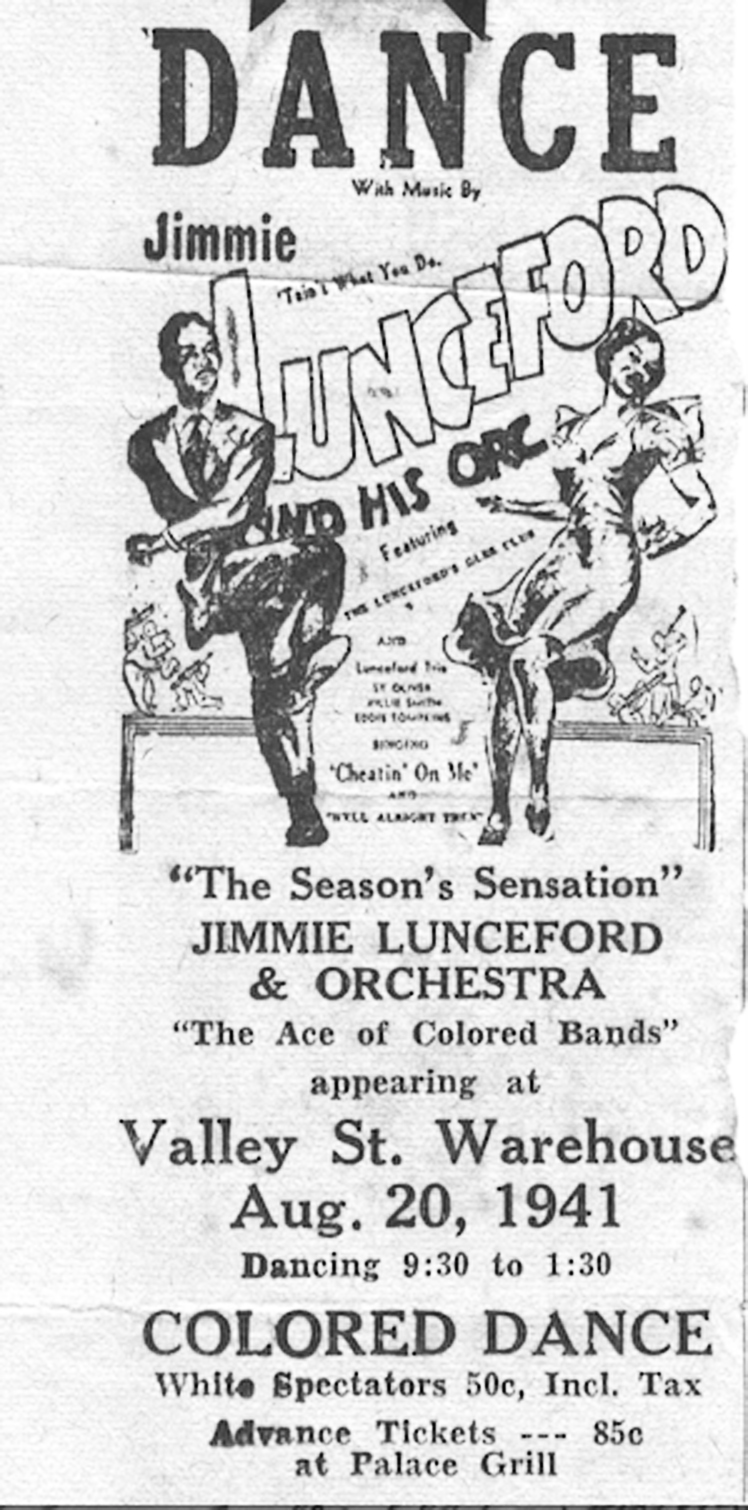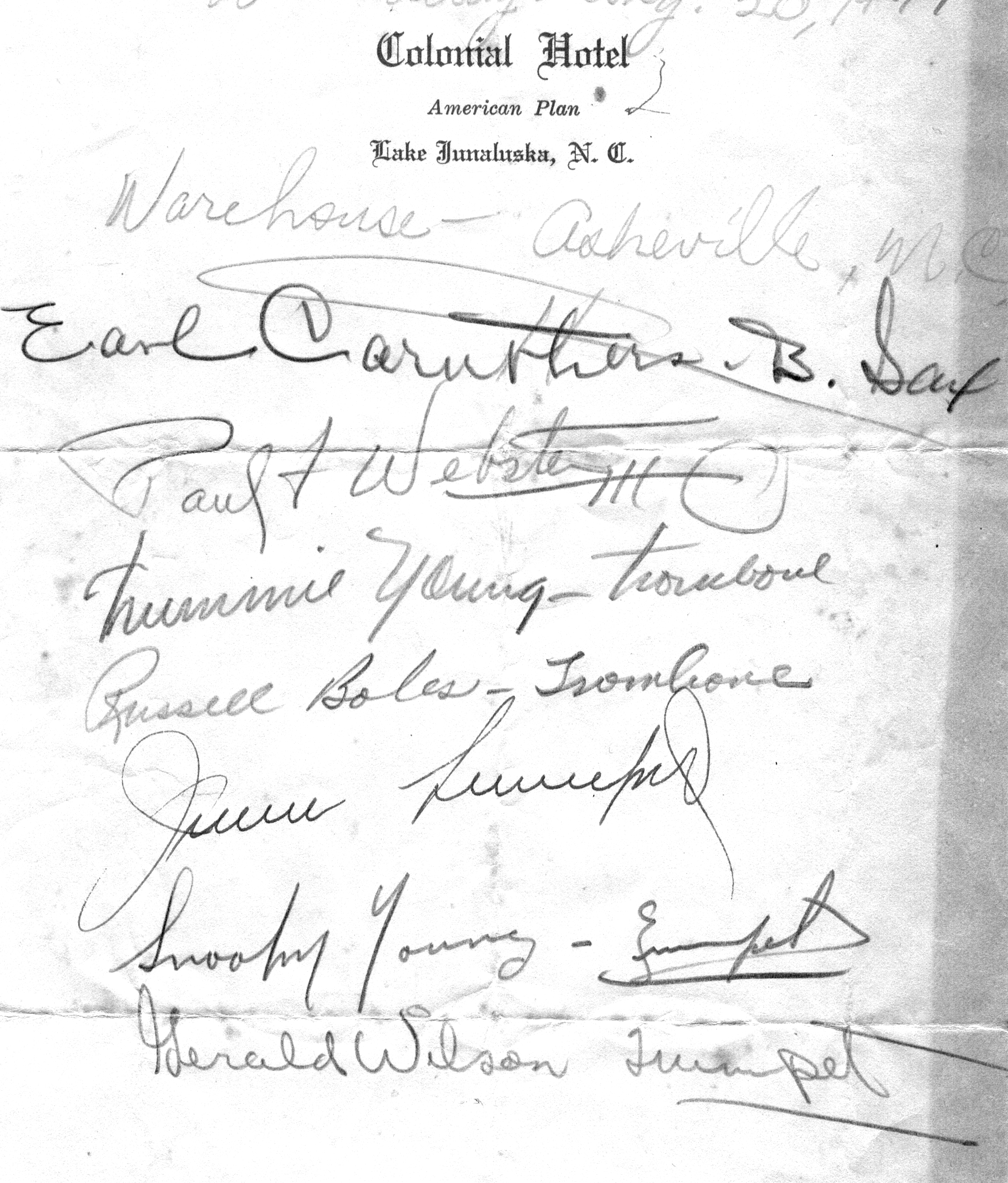Summer of ’41, before senior year in high school, I worked as bellboy at a resort hotel in Lake Junaluska, NC, a Methodist Chatauqua some 30 miles west of Asheville. One amusement was to size up the impoverished preachers and dignitaries arriving at the churchly seminars and estimate our tips as we carried up their heavy bags.
Bob Barnes, as I, the son of a Florida Methodist preacher, was my bellhop partner as well as companion in our extra-curricular pursuits of that summer. I had begun to play tenor sax while he played a fine trumpet lead and we had found some stock “Dixieland” arrangements. We put together a little combo among colleagues and somehow got a gig in a dinky roadside tavern in the nearby Carolina hills.
An advertisement in the Asheville paper for the appearance of the Jimmy Lunceford orchestra caught my eye one morning. (I’ve kept the clipping now more than eight decades). We could hardly believe our good fortune—only 30 miles away, possibly the greatest swing band ever assembled was to play for an advertised “Colored Dance” in a cotton warehouse in the countryside. But, the public was invited, including “white spectators”!! Bob and I and crew of our summer band were choked with excitement to go and hear this band, then at its pinnacle.
 Somehow we found the monstrous old warehouse, its grounds lighted with turpentine flares, deep in the backwoods and on a moonless Saturday night. Greeted cordially by a friendly member of the welcoming committee, our little clot of honky boys was informed that our ticket would cost 55 cents, for which we would receive admission plus a half-pint of the finest regional moonshine. Passing this test, the five of us were escorted through a tiny side door, just big enough to accommodate a bale of cotton, and were seated on a tier of benches reserved for a couple dozen whites, segregated behind chicken wire!
Somehow we found the monstrous old warehouse, its grounds lighted with turpentine flares, deep in the backwoods and on a moonless Saturday night. Greeted cordially by a friendly member of the welcoming committee, our little clot of honky boys was informed that our ticket would cost 55 cents, for which we would receive admission plus a half-pint of the finest regional moonshine. Passing this test, the five of us were escorted through a tiny side door, just big enough to accommodate a bale of cotton, and were seated on a tier of benches reserved for a couple dozen whites, segregated behind chicken wire!
Close to the “50-yard line,” we had a marvelous view up and down the cavernous hall, converted this occasion for dancing, with the elevated, brightly lit bandstand on our right, the bar in the darkness on our left.
All the Lunceford greats were there that night, save Sy Oliver, in the period of the bands’ great power, originality, and popularity. They were well-rehearsed, relaxed, and “hot,” following a heavy week in a New York City recording studio. And they were playing in Carolina not for fancy but for real folks! I was moved, in awe, to collect all their autographs at intermission!

The band played itself in, briskly, each musician arriving to thundering applause. Spirits rose to the rafters. From the first note the band rocked relentlessly, all night long. Rarely have scribbled notes on staff paper been transformed into such glorious bendings and swirls of sound. Never have ensembles played more tightly or smoothly, more driving and dynamic. Never were solos more soaring and innovative. In that version of the Lunceford band were the more talented musicians of the time, assembled in the more prestigious and brightly colorful portrait of a swing orchestra. The popular bands of Miller, James, and the Dorseys were, in my 16-year-old’s view, pallid pastels by comparison.
Physically the band was stunning: the powerful brown faces, impeccable double-breasted Palm Beach jackets, black bow ties and black pants, black and white wing-tip shoes, jewels flashing from many fingers, horns polished and glinting brilliantly under the lights.
That magic Saturday night in the Carolina hills our ecstatic little honky band witnessed sights, followed motions, encountered fragrances, and experienced unimagined rhythms, sounds, and harmonics. We saw joy manifest and jiving contortions on the dance floor we had no idea were within human capacity. Though pale, vapid presences on the fringes of this great brown mass of beauty and emotion, we gradually came to understand that evening our common origins but to wonder how and why our tribe had so departed from this lyrical and rhythmic legacy. We marveled at the skill and passion of a gifted people in full celebration of life. We were grateful, near-tearful witnesses to this glorious, ’til now, for us, forbidden culture.
Amen!




















